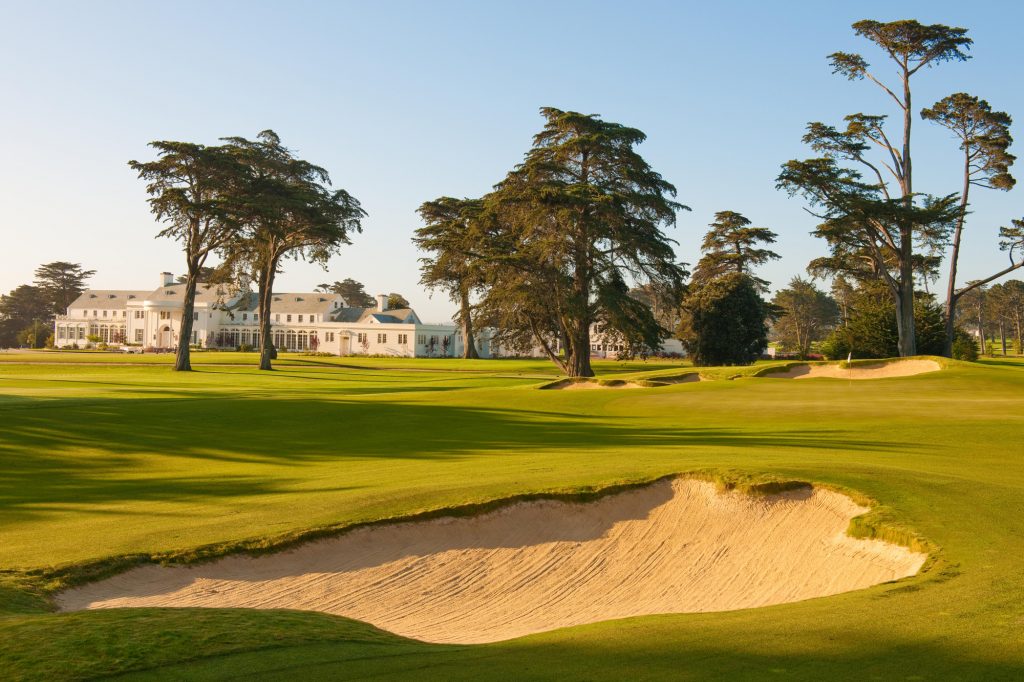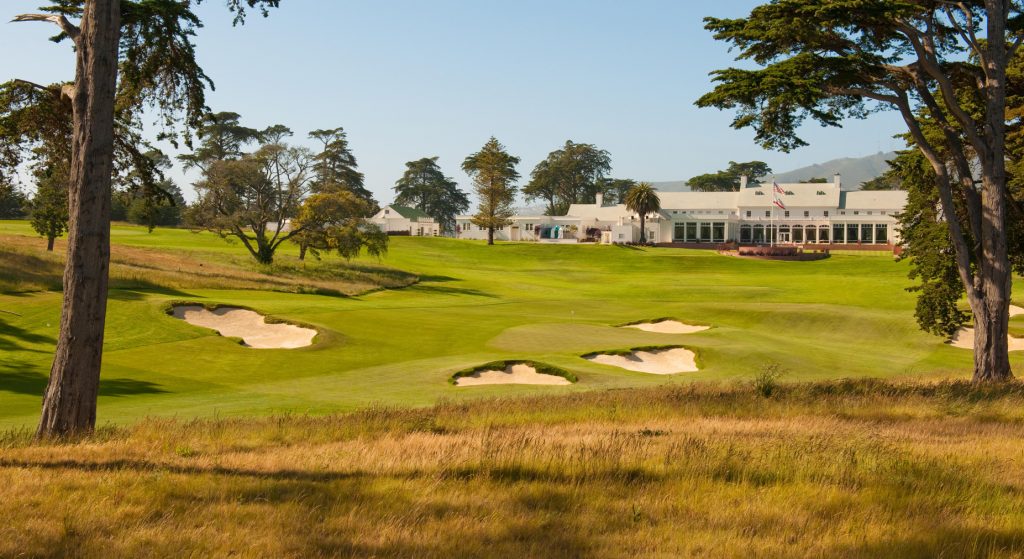Congratulations to California Golf Club of San Francisco on moving up to #50 in Golf Magazine’s 2020 Top 100 Courses in the World.




The California Club of San Francisco was once considered to fall into the second tier of San Francisco golf courses behind the likes of San Francisco Golf Club, Olympic Club or Cypress a couple of hours down the road. Originally laid out by Willie Locke, once construction began in 1924, A.V. Macan (Victoria Golf Club, Royal Colwood) came in and is considered the architect of note.
In 1927, Alister MacKenzie was commissioned to redesign all of the bunkers. From that point on, the Cal Club’s reputation started to take off. Known for his exquisite skill set when it came to bunkering, MacKenzie’s touch brought life to the fairways of the Cal Club.
Once again, through the 1960s, yet another golf course architect was brought in to make changes to the course. This time, it was Robert Trent Jones Sr. Most of his changes no longer exist because in 2005, Kyle Phillips was brought in to bring the Cal Club’s golden age architecture back to life. The goal was to make the front nine as good as the back and bring a consistent feel to the golf course. So out went the Jones bunkers, in came some new holes, a gorgeous restoration of the MacKenzie style bunkers and the dramatic flare and stunning visuals of MacKenzie.
Now, the Cal Club may very well be one of the best golf courses in America if not the world.
Apart from the wonderful bunkering, the routing really sets the Cal Club apart. Taking advantage of some beautiful, tumbling terrain, width off the tee and the lack of rough create strategy and nuances that keep the course fresh and make every hole interesting. From the first hole, a gentle par-5 opener with one of the better green complexes on the course, to the par-3 sixth hole, a golfer would never guess that by the time they reach the green on the mid-length par-3, with its green falling away gently from the tee, that they would have climbed to one of the highest points on the golf course and what must be some 150 feet of elevation change from the first tee.
On the entire course, there is not a single weak hole…just strong and stronger holes. Even on holes like the second, a new Phillips hole where the land is less interesting, a great green complex saves the day and turns what would be a somewhat dull hole into a very good one. The third, also a new hole, is a par-4 which begins with an elevated tee-shot, wraps itself around an incredible assembly of bunkers and finishes on a beautiful pushed up green.
The sixth hole is the first of what is a great collection of par-3s — a mid-length three shot hole with a green that falls away from the tee. The bunkers short tell golfers “don’t miss here,” but a closely shaved bank on the back of the green awaits those who go long.
The seventh is another of the new Phillips holes and a stunner. A true cape hole with a hazard that comes into play from both the tee and on the approach, the peninsula like green location is gorgeous and the tee-shot tempts you to cut off more than you can chew.
From eight to fourteen, Cal Club may have few matches in the world. Without going into too much detail, it’s simply a great stretch. The eighth is a beautiful par-3 with an interesting knoll front right which bounds golf balls on to the green, the ninth is a bold choice in routing with a blind tee shot up and over a ridge, the eleventh is a shorter par-4 sweeping left to a green location that is second to none, twelve is a breathtaking par-3 playing from a tee set beneath the clubhouse to a green set on a ridge line and guarded by some of the more spectacular bunkering on the course and so on.
Saving you the details of a hole by hole description, it’s enough to say that the eleventh green isn’t the only thing that’s second to none about the Cal Club…the entire course is more of the same. Kyle Phillips has done a wonderful job of restoring what was and is one of the best golf courses to be found anywhere. Width, beautiful bunkering, smart and strong routing, a spectacular property and bold greens all add up to one hec of a course — a remarkable example of golden age architecture.
BEST PAR-3 – 12th
BEST PAR-4 – Too many
BEST PAR-5 – 1st for its green
BEST VIEW – From behind the 6th green
UNDER-APPRECIATED – Course conditions which play firm and fast and make the course so good
LOVE – The feel and look of EVERYTHING
UNEXPECTED – Not necessarily unexpected, but the bunkering is exquisite
Author: Frank MastroSource: Canadian Golf Magazine
One of the state’s most prestigious golfing institutions, the California Golf Club of San Francisco was originally designed by A.V. Macan in 1925, and rebunkered a couple of years later by the great Dr Alister MacKenzie. MacKenzie’s original bunker shapes here were every bit as rugged and impressive as those at Pasatiempo and Cypress Point, but over time the hazards had lost their dramatic appearance and in the 1960s the layout was further compromised when the club lost part of its land for a road expansion. Technology also hurt the Cal Club, as the dimensions of their internal driving range became less adequate the longer the ball flew, and trees and containment mounding was thought necessary to protect golfers on the course.
The problems of deterioration were to be addressed in the early 2000s by a redesign program that caught the attention of prominent architects throughout the United States. Kyle Phillips was awarded the job, largely on the back of a radical plan to re-route the front nine, build three new holes and shift the driving range away from the clubhouse. The MacKenzie look and influence had been eroded over time and Phillips, while also creating new holes, was determined to make the Cal Club again look and feel like a MacKenzie course. His plan allowed the holes the space and sense of grandeur they deserve, and by giving breathing space to golf corridors and removing unnecessary trees the emphasis is again back on just how suitable this site is for great golf.
Unlike the nearby Olympic Club, which is essentially built on the side of a hill, Cal Club occupies erratically tumbling ground, the heavy slopes full of great natural movement and ideal for interesting golf. The rugged, naturalistic bunker shapes and restored green complexes work perfectly on this site, and give the impression that MacKenzie’s work here was never touched. That’s the biggest compliment anyone can pay Kyle Phillips regarding his work at Cal Club, that it all looks preserved from the MacKenzie plan of the 1920s.
The California Club of San Francisco is a great place for golf, and after years of darkness the club once again owns a genuine American classic. The golf holes are inviting, varied and original, the green surfaces beautifully pitched to accept well struck balls and the bunkers are strategically arranged and attractively constructed. Appointing Phillips to oversee this important program was a bold one, but the designer did a wonderful job here and the course is now once again heads and shoulders above better known San Francisco layouts like Harding Park and Olympic Lake.
By: Darius Oliver
After a brilliant restoration, this rolling layout that Alister Mackenzie left his mark on reassumes its place in the pantheon of Great Bay Area Courses. – By Tom Cunneff
Straddling opposite sides of Lake Merced, San Francisco Golf Club and U.S. Open Host The Olympic Club have rightfully earned their reputations as the city’s best courses. But seven miles to the southeast, there’s another club that is every bit their equal after a $13 Million renovation: California Golf Club of San Francisco. In 2007-8 Kyle Phillips restored the course to its Golden Age splendor when Alister Mackenzie redid all the bunkers and few of the greens.
“Before when people came to San Francisco they thought of just two courses—Olympic and San Francisco,” says Phillips, whose other credits include Kingsbarns and Dundonald in Scotland, and Yas Links in Abu Dhabi. “But now, mainly through word of mouth, there’s another one that people are saying, ‘We’ve got to check this out.’ It’s been gratifying.”
What visitors find are long-range views of the Bay Area, stunning bunkering, and rolling terrain with firm-and-fast conditions. Unlike most other layouts in coastal California where spongy poa and sticky kikuyu dominate, Cal Club features fine fescue and colonial bent fairways and bent greens that allow the ground game to flourish. Read More…
WORK BY THOMAS BASTIS AND KYLE PHILLIPS GUIDES CALIFORNIA GOLF CLUB TO NEW HEIGHTS
By John Reitman
South San Francisco, Calif.
Sometimes, credit is the other side of blame. Consider Thomas Bastis, superintendent of the California Golf Club of San Francisco.
A $13 million restoration by architect Kyle Phillips in 2007-08 might be responsible for launching the Cal Club onto the Golfweek’s Best Classic Course list in 2009, at No. 60. But it’s Bastis who looks after the retro-look layout that keeps the Cal Club moving up the charts — to No. 54 last year and an eye-popping leap of 19 spots this year, to No. 35.
“It’s so fresh and different from where it was,” Phillips said. “Thomas has done a great job at keeping the course firm and fast. It’s a happy story; the kind you want when you get involved in a project”. Read More…
For anyone who thinks that great golf course architecture is found only at old, stuffy private clubs, the 2010 Golfweek’s Best lists should be an eye-opener… Link to rest of article.
Golf Week’s Best Classic Courses Before 1960
54. California Golf Club 7.25
(60, p) South San Francisco, Calif.
1926, Vernon Macan; Alister MacKenzie (1928); Kyle Philips (2007)
Golf Week
March 2010
Brad Klein
2009 Golfweek’s Best Classic Courses
THE CLASSICS before 1960
60. California Golf Club 7.11
(NR; p) South San Francisco, Calif.
1926, Vernon Macan; Alister MacKenzie, Kyle Philips (2007)
http://top100.golfweek.com/GolfweeksBest/article.asp?ID=1608
…The runaway winner of “Comeback of the Year” is California Golf Club in South San Francisco, Calif., which appears as No. 60 on the Classic after a yearlong shutdown and massive restoration/renovation project. Bay Area golf aficionados always had
respected the 1926 Vernon Macan design, especially after it was treated to highly-stylized bunkering by Alister MacKenzie. But the course suffered a clumsy partial rerouting in the mid-1960s.
California GC enjoyed the national rating limelight for one brief stint at No. 92 in 2003, and then fell off the Classic list as tree problems, a nematode infestation and poor drainage took their toll.
Starting in August 2007, architect Kyle Phillips, working closely with
course superintendent Thomas Bastis, undertook a gutsy project: five retro
holes created, the practice range moved, two clumsy ponds filled in, 450 yards added and the old fairway widths and bunkering restored. Along the way they also dealt with eucalyptus and pine trees that had overgrown the grounds.
The boldest move was utilizing a virtually abandoned l7-acre dump site on a hill overlooking the bulk of the course and using it for California GC’s seventh hole, a
stunning, wrap-around 402-yard par 4 where the fairway clings to the edge.
Golfweek
Bradley S. Klein
www.golfweek.com
As one of the Bay Area’s oldest and most respected private clubs, California Golf Club of San Francisco reopened to its members this summer in grand fashion. The first event at the newly renovated course was highlighted with a 6-hole exhibition by PGA Tour player Arron Oberholser and former U.S. Open Champion Ken Venturi hitting the ceremonial first ball.
Read More…